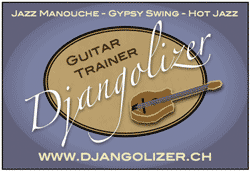
5 - Jazz Harmonies
The chord table
In Gypsy Swing, the chord progression of a song is notated in form of a chord table. In french it's called "grille" (grid).
Thanks to the graphical division into 8 measures per row, the chords can be registered and memorized easier, than from a score sheet in a fakebook.
To be a good Jazz musician, you need to know the chords of each song by heart!
Typical chord progressions in Swing Jazz
There are general chord changes in Swing music. The most important ones
are listed below.- 5-1 chord progression (tension -> release)
- 2-5-1 chord progression in major and minor
- Rhythm Changes
- Turnarounds, which are quite similar to the Rhythm Changes
- Dominant-Sept progression in quart steps
- Church mode quart progression
- Christophes (turnaround of eight bars)
- 2-5-1 chord progression in major and minor
- Rhythm Changes
- Turnarounds, which are quite similar to the Rhythm Changes
- Dominant-Sept progression in quart steps
- Church mode quart progression
- Christophes (turnaround of eight bars)
The more often you play these chord changes, the more you will recognise them in new songs, by seeing the chords but also by hearing them. When you are familiar with those chord progressions, you will learn new songs very quick.
The basic chord change: 5-1 (V-I)
In music, it is all about generating tension and relieving it afterwards. The two chords with the biggest disharmony to each other are the fifth mode (dominant, tension) and the first mode (tonic, relaxation). You will find such 5 - 1 progressions in every song!Usually, the modes are specified with roman numbers: V - I (but sometimes I write them here in standard numbers, because we are more used to them).
In C major the chords are G7 und C.
In C minor the chords are G7b9 und Cm.
In "Minor Swing" they are E7 - Am

Djangolizer Power-User
To practice 5-1 chord changes, load the exercises"Ex - Major 5-1 progressions" and "Ex - Minor 5-1 progressions".
In those exercises, you have many combinations of chords with different extensions.
It is a matter of taste and the playability in higher tempos, what chord combination you will play in your songs.
2-5-1 chord changes
A classic chord progression in Jazz is the 2-5-1 connection (IIm - V -
I).You will find it in almost every Jazz standard.
Here the 2-5-1 chord change in major

and here in minor

Please note, that the V7 in minor can be played with an added flat 9th.
Djangolizer Power-User
You will find some exercises called "Ex - Major 2-5-1 Quart Circle" and "Ex - Minor 2-5-1 Quart Circle" in the Djangolizer library. Practice the 2-5-1 progressions in C major and C minor first. After mastering them, practice all the other tonalities as well. Set the loop to 4 measures. Do the exercises over the two positions, shown in the "Full Fretboard" view.Here a small selection of songs with 2-5-1 chord changes…
- "Blue Bossa", in C minor and C# major
- "For Sephora", in E minor and G major
- "Honeysuckle Rose", in F major
- "Black Orpheus", in C major, A minor and D minor
Rhythm Change
Rhythm Changes are sequences over 8 bars. The chord changes are 1-6-2-5. Each chord is played half a bar.At the 5th measure is a tonality change from the first mode (Ionian) to the fourth mode (Lydian).
In C major, that would be F major. The harmony leads then back to C major via a F# diminished chord.
Rhythm Changes are also called "Anatol".
Here is the A-part of "Heavy Artillery" or "Swing Guitars"
The cool thing about Rhythm changes is, that you can play with the Ionian scale over all the 8 bars. They are very easy to transpose to other tonalities.
The difference between Rhythm Change compositions are the B parts, but those 8 bars are easy to remember.
The conclusion is: If you know one Rhythm Change, you know them all (more or less) :-)
After the Dm7 chord you can play a G13b9 instead of a G7 chord. It is easier to grab and sounds more modern, but has the same harmonic nature.
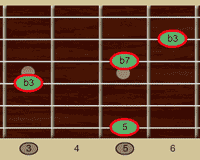
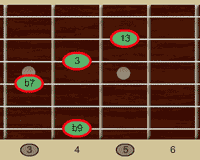
Dm7 and G13b9 chords
Djangolizer Power-User
Typical Rhythm Changes are…Babik (F)
Belleville (D)
Daphne (D)
Heavy Artillery (C)
Swing 42 (C)
Swing Guitars (C)
Double Scotch (C)
Micro (G)
Turnarounds
Turnarounds have chord changes related to the Rhythm Changes.Usually they are played at the end of a part.
Here the last bars of "Hungaria" without turnaround.

Here the last bars of "Hungaria" with a turnaround at bars 31-32.

To reduce the movement of their fingers to a minimum, rhythm players like to play the following chords as you can see them in the pictures below.
You start the G chord with his third (3) in the bass.
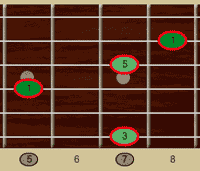
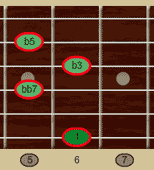
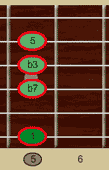
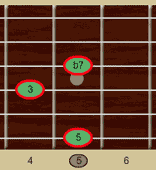
G - A#dim7 - Am7 - D7
To make the chords easier to play, you can leave the notes on the B-string away.
The dominant 7th progression
Another chord progression you will find often is the connection of dominant 7th chords.Those chords connect with intervals of quarts.
C7 - F7 - Bb7 - Eb7 - Ab7 - Db7 - Gb7 - B7 - E7 - A7 - D7 - G7 - C7 and so on…
In the majority of cases, the dominant 7th chain leads over three chords to the root chord, as you can see for example in "Hungaria": E7 - A7 - D7 - G (Bars 7-13)
Djangolizer Power-User
To practice dominant 7th progressions, select the song "Ex - Dominant Quart Circle".You can find dominant 7th progressions in songs like…
- "After you've gone" E7-A7-D7
- "Sweet Georgia Brown" E7-A7-D7
- "Sheik of Araby" D7-G7-C7
- "Stompin' at Decca" B7-E7-A7-D7
Church mode quart progression
There is one more very conventional chord progression, which you can find in many Jazz standards. It is the chord change in quarts through the church modes.You will find it in songs like "Autumn Leaves" and "For Sephora".
Chord chains in quarts sound very natural for western ears.
The guitar is tuned in quart steps!
Djangolizer Power-User
Play the following exercise in all 12 tonalities."Ex - Churchmode Quart Progression"
Christophe
A Christophe is a chord progression over 8 bars and can be seen as a turnaround. It is played at the last 8 bars of a chorus.It starts with a chord of the 4th mode (IV maj), followed by a minor chord of the 4th mode (IV m). Some Christophes are played with a diminished chord, one halfnote higher than the 4th mode (IV# dim).
Here you have two examples of Christophes...
Christophe in C major with a Fm6 chord at bar 2

Christophe, in C major with a diminished chord at bar 2

Djangolizer Power-User
Here some songs with Christophes…All of me (C)
I can't give anything but love (G or F)
Them there eyes (D)
Hungaria (G)
Django's Tiger (A)
Some of these days (G or F)
Various versions of a song
When you check out the song library in Djangolizer, you may wonder, why there are multiple versions of some songs.As we saw in the chapter "Jazz chords", chords can be exchanged by substitutes.
Another variation is possible by playing a major chord with another extension.
Instead of C you could play Cmaj7, C6, C69 or Cmaj9 as well.
You can add or omit chords as well. For example, you could add a second mode IIm7 to a fifth mode. For eaxample, play IIm7 - V7 instead of V7 - V7.
Below you can check the various versions of "Blues Clair".
To make the harmony
Im folgenden werden die verschiedenen Versionen von "Blues Clair" aufgeführt. Zusätzlich habe ich die Akkorde mit ihren Stufen (Modes) bezeichnet.

The simple version is reduced to the absolute basic chords of the song.
Another reduction could be to leave out the extensions. Just C instead of C6.
But you should not leave out the 7 of a dominant chord!

Above is a semicomplex verson. It is playable well at higher tempos.
The Ebdim7 is used as a transit chord from C6 to Dm7.

This version will be quite difficult to play it groovy and smooth at a high tempo.
The Gbdim7 and Ebdim7 are used as transit chords.
When you get bored while playing the rhythm guitar, try to change between those song versions. Simplify other songs or add some chords by your own.
Bring some variety in your rhythms.
Djangolizer Power-User
Check the exercise "Ex - Song Harmony Diversity" to get a variety of chord combinations over the same harmony.If you are curious, compare the various versions of…
"Nuages"
"Anniversary Song" ("Danube")
"Coquette"
"Confessin, that I love you"
"Honeysuckle Rose"
"I can't give you anything but love"
Conclusion:
Rhythm Master
If you have a blackout, while playing the rhythm guitar, act as if you are still doing a good job. Keep on strumming with your right hand, but make a scratchy sound, while you try to find the next chord of the song.To be a good rhythm player is a desirable and time-consuming job.
I believe that somebody can only be a good soloist, when he has mastered the rhythm play.



